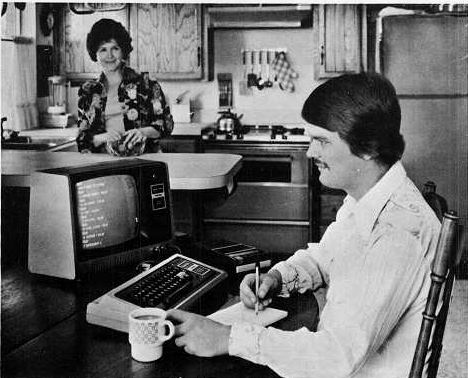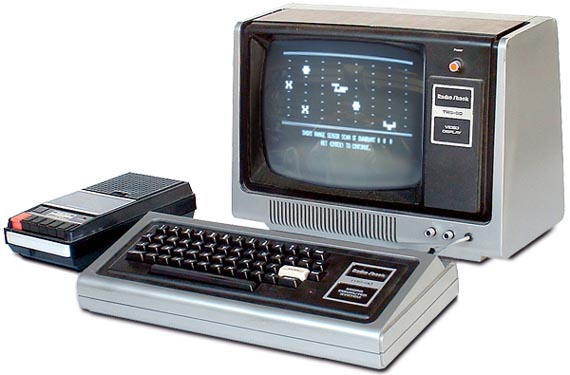As computers began to enter homes in reasonable numbers in 1977 and 1978, bemused (or not so bemused) spouses, parents, children, siblings, and roommates all asked the same question: but what can you actually do with it? Proud new owners didn’t find that a very easy question to answer, for these machines were absurdly limited; the TRS-80 had no color capabilities, only the barest of graphical capabilities, no sound, no lower case letters, for God’s sake. (Radio Shack, in what should be becoming a familiar theme by now, refused to splurge for the $2.00 or so they would have cost to include.) It was not even possible to connect a printer to the TRS-80 prior to the arrival of Radio Shack’s expensive “expansion interface” in mid-1978. Even the staple justification of a few years later for buying a computer — “We can use it for word processing, and the kids can do their school reports on it” — wouldn’t quite fly with 1977-era machines.
The TRS-80 shipped with two programs on an accompanying cassette, computerized versions of backgammon and blackjack. Radio Shack also had four “productivity applications” already available at launch. There were, for starters, some educational software to help the kids out in math and a personal finance system (Quicken in 4 K!). There was also a payroll program, presumably the same one that French and Leininger had demonstrated to Charles Tandy, head of the company, to sell him on the potential of the TRS-80; the program crashed when Tandy entered an annual salary (his own) too large for it to handle.
And there was a “kitchen” utility bundle, which could convert measurements and store messages for other family members. This last demonstrates how confused even Radio Shack was about what their computer would actually get used for. They seemed quite high on the idea of a TRS-80 in the kitchen, often including pictures of exactly that in their promotional literature, yet one has to wonder just what advantage a balky computer with cassette-based storage offers over a calculator and a good old pencil and pad. Solutions like this, far more convoluted and time consuming than the traditional methods they wanted to replace, were everywhere in the early software market. Hard as Radio Shack and owners might have tried to justify the TRS-80 as a “serious” tool, it’s probably safe to say that virtually all who purchased them wanted first and foremost just to play with them. No wonder they shipped with two games as their standard software starter package.
Still, Radio Shack showed considerable foresight in realizing that their machine needed supporting software. They actively encouraged early adopters to provide it, making it known that they would sell the best efforts in their stores, a plan that worked rather brilliantly and doubtless contributed to the TRS-80’s having a much larger software library than its competitors from Apple and Commodore by 1979. While that pipeline was ramping up, though, users had to find other ways of making their TRS-80s do something. One possibility, of course, was to write their own programs. To support this approach, the TRS-80 shipped with a thorough and friendly BASIC tutorial written by David Lien that is still regarded as something of a classic of its genre today. Yet many craved complete, working programs that they could enter and run, if only to learn from them and to use them as a base from which to start off on their own BASIC explorations.
Luckily, they quickly found a substantial library of code from which to draw. By 1977 BASIC had been in active use on larger institutional computers for well more than a decade, resulting in a large library of programs just waiting to be keyed into all those new TRS-80s. In the very early months there were sharp limitations imposed by available memory and by a primitive implementation of BASIC, but with the arrival of 16 K machines and Level 2 BASIC it became possible to port most of the extant BASIC library to the TRS-80 with relatively little effort, as well as to move programs among the three otherwise incompatible home-computer models of the era. Thus BASIC became a lingua franca, a bridge among all of these very different machines (or, if you like, the Java of the late 1970s). Huge swathes of the BASIC code that users of machines like the HP-2100 series had been trading and tinkering with for years now made their way into bedrooms and living rooms. Suddenly the back catalog of programs previously published in places like Creative Computing had new significance. Showing perfect timing, the magazine had published two “best of” collections as books in 1976 and 1977, full of programs to enter and programming problems to solve; both books now began to sell very well indeed to a new audience of microcomputer owners. In 1978 Creative Computing published BASIC Computer Games, a revision of a book its founder David Ahl had first published in 1973. It included 101 games taken from the magazine’s first five years and before, born of places like the People’s Computer Company, and it became a huge hit, a touchstone for a whole generation of budding gamers and programmers.
Of the programs I discussed previously in this blog, Hunt the Wumpus along with its predecessor games made it onto the TRS-80 in fairly short order. The Oregon Trail initially did not, perhaps due to MECC beginning to realize it had a valuable property under its hands and beginning to claim copyright protections, but in its October, 1979, issue SoftSide magazine published something called Westward 1847, allegedly by one John C. Sherman. A quick look at the code reveals Westward to be our old friend The Oregon Trail with modifications to let it run on the TRS-80. As for Adventure… well, that was a much more complex program and also not written in BASIC, making it a tougher nut to crack. I’ll come back to that soon.
Also among the programs that now began appearing on these new microcomputers was a curious simulation of a psychotherapy session. More on that hugely important program and its legacy next time.












